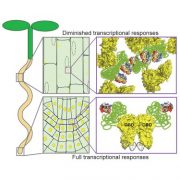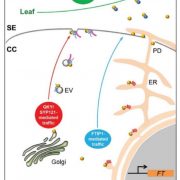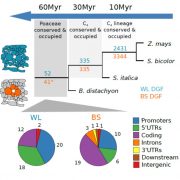
teosinte branched1 and the control of bud dormancy and growth in maize (Nature Comms)
Plant Science Research WeeklyBranching has a significant impact on plant architecture. Maize, a domesticated species, has lower branching levels in comparison to its wild ancestor teosinte. Axillary branching is the result of lateral buds growth. Some factors such as phytohormones and transport of sugars are related to bud activation/dormancy…

Evolution of the KANADI gene family and leaf development in lycophytes and ferns ($) (Plants)
Plant Science Research WeeklyPlants constantly grow post embryonically through shoot and root apical meristems. Multiple transcriptional factors and other regulators fine-tune such growth. Leaf growth from the apical meristem is well studied in the model plant Arabidopsis where two main transcription factors, namely HD-ZIP III (Class…

Nuclear-cytoplasmic partitioning of ARF proteins controls auxin responses ($) (Mol Cell)
Plant Science Research WeeklyARF (Auxin Response Factor) transcription factor proteins contain three domains: an N-terminal DNA-binding domain, a variable middle region, and a C-terminal PB1 domain. Powers et al. found that ARF7 and ARF19 accumulate as large-order assemblies in the cytoplasmic region of mature root cells, but the…

The QKY-SYP121 complex controls long-distance florigen movement ($) (Plant Cell)
Plant Science Research WeeklyIn Arabidopsis thaliana, changes in day-length (photoperiod) activate the expression and transport of phloem-mobile florigen (FT, FLOWERING LOCUS T) to the shoot apical meristem to trigger the transition to flowering. While the role of FT as a long-distance signal is well-established, the underlying…

Halotropism requires phospholipase Dζ1‐mediated modulation of cellular polarity of auxin transport carriers ($) (Plant Cell Environ)
Plant Science Research WeeklyPhospholipase D (PLD) enzymes cleave phosopholipds to release phosphatidic acid (PA), which is a signal that affects membrane dynamics. Previous studies have indicated a role for PLD and PA in root responses to osmotic and salt stress, but as the Arabidopsis genome has 12 genes encoding PLD questions…

A single amino-acid substitution impairs PTI and ETI in an SA-dependent manner in rice ($) (Plant Physiol)
Plant Science Research WeeklyPlants possess two immune strategies to prevent invasion by pathogens called pattern-triggered immunity (PTI, typically mediated by cell-surface receptors) and effector-triggered immunity (ETI). During ETI, intracellular resistance (R) proteins perceive specific pathogen effectors. Tang et al. describe…

Genome-wide transcription factor binding in leaves from C3 and C4 grasses (Plant Cell)
Plant Science Research WeeklyMost plants use the C3 photosynthesis pathway, however many have evolved strategies like C4 photosynthesis that accumulate CO2 around RuBisCO. Burgess et al. performed DNAseI-SEQ in three C4 plants: S. bicolor, Z. mays and S. italica, and one C3: B. dystachion, to offer an insight into the cis-element…

Plant Science Research Weekly: Sept. 13
Blog, WWR Full PostReview: Revolutions in agriculture chart a course for targeted breeding of old and new crops ($)
A few traits are associated with domestication across many species. Eshed and Lippman provide an overview of the changes to plant stature and flowering time that have been repeatedly selected by our…

Faculty Job: Myths & Realities - an interview with Suayib Üstün
Blog0 Comments
/
About you
Describe your journey from student to newly appointed faculty
My academic path was not always straight forward. 15 years ago, I read in a magazine that doing bioinformatics will be the job of the future (which it is now!), and I decided to enroll in bioinformatics at the University of…

